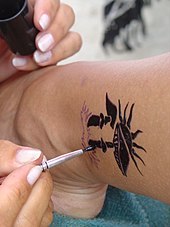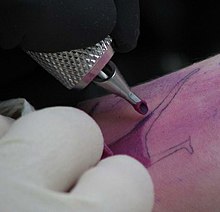 Tattoo medical issues
Tattoo medical issuesModern tattoo artist's nitrile gloves and sterilized equipment
Because it requires breaking the skin barrier, tattooing may carry health risks, including infection and allergic reactions. Modern tattooists reduce such risks by following universal precautions, working with single-use items, and sterilizing their equipment after each use. Many jurisdictions require that tattooists have bloodborne pathogen training, such as is provided through the Red Cross and OSHA.
In amateur tattoos, such as those applied in prisons, however, there is an elevated risk of infection. Infections that can theoretically be transmitted by the use of unsterilized tattoo equipment or contaminated ink include surface infections of the skin, herpes simplex virus, tetanus, staph, fungal infections, some forms of hepatitis, tuberculosis, and HIV.
 Temporary tattoos are popular with models and children as they involve no permanent alteration of the skin but produce a similar appearance that can last anywhere from a few days to several weeks. The most common style is a type of body sticker similar to a decal, which is typically transferred to the skin using water. Although the design is waterproof, it can be removed easily with oil-based creams. Originally inserted as a prize in bubble gum packages, they consisted of a poor quality ink transfer that would easily come off with water or rubbing. Today's vegetable dye temporaries can look extremely realistic and adhere up to 3 weeks due to a layer of glue similar to that found on an adhesive bandage.
Temporary tattoos are popular with models and children as they involve no permanent alteration of the skin but produce a similar appearance that can last anywhere from a few days to several weeks. The most common style is a type of body sticker similar to a decal, which is typically transferred to the skin using water. Although the design is waterproof, it can be removed easily with oil-based creams. Originally inserted as a prize in bubble gum packages, they consisted of a poor quality ink transfer that would easily come off with water or rubbing. Today's vegetable dye temporaries can look extremely realistic and adhere up to 3 weeks due to a layer of glue similar to that found on an adhesive bandage.Henna tattoos (Mehndi) and silver nitrate stains that appear when exposed to ultraviolet light can take up to two weeks to fade from the skin. Temporary airbrush tattoos (TATs) are applied by covering the skin with a stencil and spraying the skin with ink. In the past, this form of tattoo only lasted about a week. With the newest inks, tattoos can reasonably last for up to two weeks.
 Procedure
ProcedureModern tattoo machine in use: here outfitted with a 5-needle setup, but number of needles depends on size and shading desired.
Tattooing involves the placement of pigment into the skin's dermis, the layer of dermal tissue underlying the epidermis. After initial injection, pigment is dispersed throughout a homogenized damaged layer down through the epidermis and upper dermis, in both of which the presence of foreign material activates the immune system's phagocytes to engulf the pigment particles.
 In Japan, tattoos are strongly associated with a particular organized crime organization known as the yakuza, particularly full body tattoos done the traditional Japanese way (Tebori). Many public Japanese bathhouses (sentō) and gymnasiums often openly ban those bearing large or graphic tattoos in an attempt to prevent Yakuza from entering
In Japan, tattoos are strongly associated with a particular organized crime organization known as the yakuza, particularly full body tattoos done the traditional Japanese way (Tebori). Many public Japanese bathhouses (sentō) and gymnasiums often openly ban those bearing large or graphic tattoos in an attempt to prevent Yakuza from entering Tattoos have experienced a resurgence in popularity in many parts of the world, particularly in North and South America, Japan, and Europe. The growth in tattoo culture has seen an influx of new artists into the industry, many of whom have technical and fine arts training. Coupled with advancements in tattoo pigments and the ongoing refinement of the equipment used for tattooing, this has led to an improvement in the quality of tattoos being produced.
Tattoos have experienced a resurgence in popularity in many parts of the world, particularly in North and South America, Japan, and Europe. The growth in tattoo culture has seen an influx of new artists into the industry, many of whom have technical and fine arts training. Coupled with advancements in tattoo pigments and the ongoing refinement of the equipment used for tattooing, this has led to an improvement in the quality of tattoos being produced.During the first decade of the 21st century, the presence of tattoos became evident within pop culture, inspiring television shows such as A&E's Inked and TLC's Miami Ink and LA Ink. The decoration of blues singer Janis Joplin with a wristlet and a small heart on her left breast, by the San Francisco tattoo artist Lyle Tuttle, has been called a seminal moment in the popular acceptance of tattoos as art.
 In many traditional cultures tattooing has also enjoyed a resurgence, partially in deference to cultural heritage. Historically, a decline in traditional tribal tattooing in Europe occurred with the spread of Christianity. However, some Christian groups, such as the Knights of St. John of Malta, sported tattoos to show their allegiance. A decline often occurred in other cultures following European efforts to convert aboriginal and indigenous people to Western religious and cultural practices that held tattooing to be a "pagan" or "heathen" activity. Within some traditional indigenous cultures, tattooing takes place within the context of a rite of passage between adolescence and adulthood.
In many traditional cultures tattooing has also enjoyed a resurgence, partially in deference to cultural heritage. Historically, a decline in traditional tribal tattooing in Europe occurred with the spread of Christianity. However, some Christian groups, such as the Knights of St. John of Malta, sported tattoos to show their allegiance. A decline often occurred in other cultures following European efforts to convert aboriginal and indigenous people to Western religious and cultural practices that held tattooing to be a "pagan" or "heathen" activity. Within some traditional indigenous cultures, tattooing takes place within the context of a rite of passage between adolescence and adulthood. Among Catholic Croats in Bosnia and Herzegovina, tattoos with Christian symbols would be inked on to protect themselves from the Muslim Turks.
Among Catholic Croats in Bosnia and Herzegovina, tattoos with Christian symbols would be inked on to protect themselves from the Muslim Turks. History of tattooing
History of tattooingTattooing has been a Eurasian practice at least since around Neolithic times. Ötzi the Iceman, dating from the fourth to fifth millennium BC, was found in the Ötz valley in the Alps and had approximately 57 carbon tattoos consisting of simple dots and lines on his lower spine, behind his left knee, and on his right ankle. These tattoos were thought to be a form of healing because of their placement which resembles acupuncture.
Post Title
→History tattoo
Post URL
→http://googletattoos.blogspot.com/2010/09/history-tattoo.html
Visit google tattoos for Daily Updated Wedding Dresses Collection




0 comments:
Post a Comment